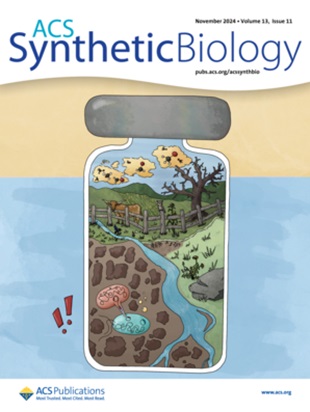评估模型复杂性对预测合成遗传电路鲁棒性的贡献
IF 3.9
2区 生物学
Q1 BIOCHEMICAL RESEARCH METHODS
引用次数: 0
摘要
设计-构建-测试-学习 "工作流程在合成生物学中至关重要,因为它旨在通过最新的自动化进步,扩大对不同层次专业知识的利用,并提高电路的复杂性。复杂电路的设计取决于开发精确的模型和参数值,以预测电路性能和抗噪声能力。然而,在各种实验条件下获取特征参数是一项重大挑战,往往需要大量的时间、资金和专业知识。这项研究比较了相同逻辑函数的三种不同遗传电路实现的五个计算模型,以评估它们的相对预测能力。主要重点是确定较简单的模型是否能得出与较复杂模型类似的结论,以及某些模型是否能提供更大的分析优势。这些模型探讨了噪声、参数化和模型复杂性对通过仿真预测合成电路性能的影响。研究结果表明,在开发没有特征部件的新电路或现有设计时,任何模型都能通过定性比较设计的失效概率(如更高或更低)来有效预测最佳实施方案。然而,当有特征化零件且希望准确量化故障概率差异时,就有必要采用带有特征化零件的更精确模型,尽管这需要额外的努力。本文章由计算机程序翻译,如有差异,请以英文原文为准。

Evaluating the Contribution of Model Complexity in Predicting Robustness in Synthetic Genetic Circuits
The design–build–test–learn workflow is pivotal in synthetic biology as it seeks to broaden access to diverse levels of expertise and enhance circuit complexity through recent advancements in automation. The design of complex circuits depends on developing precise models and parameter values for predicting the circuit performance and noise resilience. However, obtaining characterized parameters under diverse experimental conditions is a significant challenge, often requiring substantial time, funding, and expertise. This work compares five computational models of three different genetic circuit implementations of the same logic function to evaluate their relative predictive capabilities. The primary focus is on determining whether simpler models can yield conclusions similar to those of more complex ones and whether certain models offer greater analytical benefits. These models explore the influence of noise, parametrization, and model complexity on predictions of synthetic circuit performance through simulation. The findings suggest that when developing a new circuit without characterized parts or an existing design, any model can effectively predict the optimal implementation by facilitating qualitative comparison of designs’ failure probabilities (e.g., higher or lower). However, when characterized parts are available and accurate quantitative differences in failure probabilities are desired, employing a more precise model with characterized parts becomes necessary, albeit requiring additional effort.
求助全文
通过发布文献求助,成功后即可免费获取论文全文。
去求助
来源期刊
CiteScore
8.00
自引率
10.60%
发文量
380
审稿时长
6-12 weeks
期刊介绍:
The journal is particularly interested in studies on the design and synthesis of new genetic circuits and gene products; computational methods in the design of systems; and integrative applied approaches to understanding disease and metabolism.
Topics may include, but are not limited to:
Design and optimization of genetic systems
Genetic circuit design and their principles for their organization into programs
Computational methods to aid the design of genetic systems
Experimental methods to quantify genetic parts, circuits, and metabolic fluxes
Genetic parts libraries: their creation, analysis, and ontological representation
Protein engineering including computational design
Metabolic engineering and cellular manufacturing, including biomass conversion
Natural product access, engineering, and production
Creative and innovative applications of cellular programming
Medical applications, tissue engineering, and the programming of therapeutic cells
Minimal cell design and construction
Genomics and genome replacement strategies
Viral engineering
Automated and robotic assembly platforms for synthetic biology
DNA synthesis methodologies
Metagenomics and synthetic metagenomic analysis
Bioinformatics applied to gene discovery, chemoinformatics, and pathway construction
Gene optimization
Methods for genome-scale measurements of transcription and metabolomics
Systems biology and methods to integrate multiple data sources
in vitro and cell-free synthetic biology and molecular programming
Nucleic acid engineering.

 求助内容:
求助内容: 应助结果提醒方式:
应助结果提醒方式:


